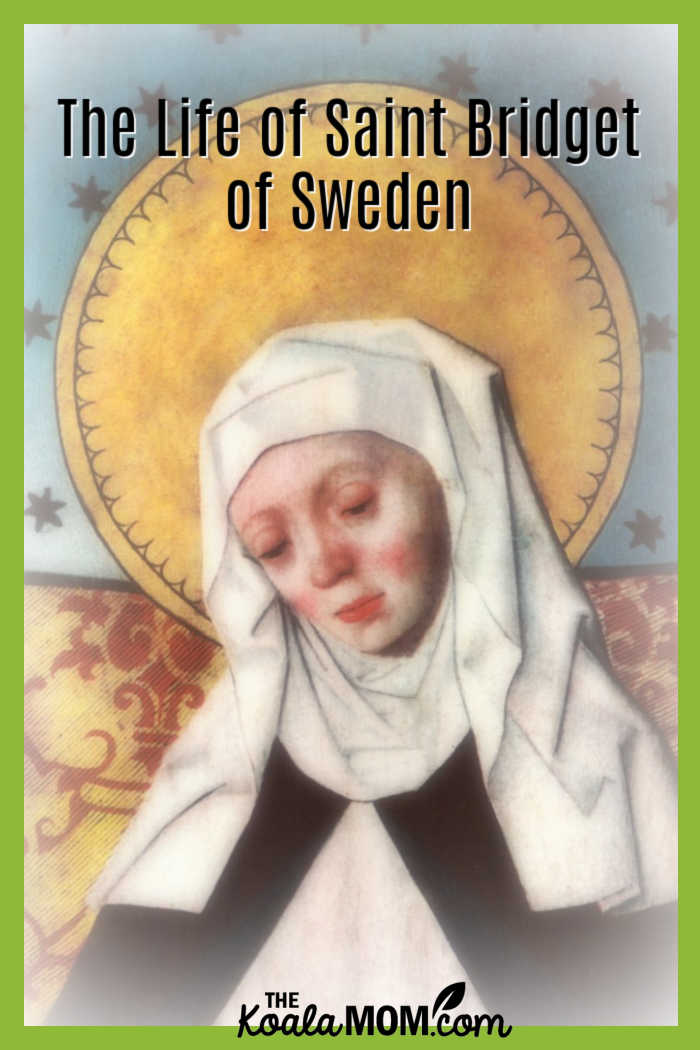July 23 is the feast day of Saint Bridget of Sweden. I first learned about her when I was pregnant with my second daughter Lily and, since she’d given birth to eight children, asked that she pray for me. Besides being a wife and mom, she was also a nun, lady-in-waiting to a queen, and an advocate of peace and social change.

This post contains affiliate links; as an Amazon associate, I earn from qualifying purchases.
In 1999, Pope John Paul II recognized St. Bridget’s great influence across Europe by naming her one of the patronesses of Europe. Saint Bridget served her king, her husband, her children, and her God in a variety of roles and her life still offers a powerful, inspiring example for women today.
Saint Bridget’s Childhood
Bridget’s father was a wealthy governor and judge in Sweden. Both her parents were very pious. She was born in about 1303, but her mother died when she was twelve. Bridget, along with a younger sister and an infant brother, was then raised by an aunt.
“It wasn’t Bridget’s dream to get married and have children; rather, she longed from an early age to become a nun. But she was obedient to her prominent family’s desire that she marry a prince.” ~ Melanie Rigney, Sisterhood of Saints: Daily Guidance and Inspiration
When Bridget was thirteen, she married eighteen-year-old Ulf Gudmarsson.
Saint Bridget’s Marriage and Family
They had a happy marriage; Bridget said she loved Ulf as she loved her own body. Pope Benedict XVI says her marriage “helps us to appreciate what today we could define an authentic ‘conjugal spirituality’: Together, Christian spouses can follow a path of sanctity, supported by the grace of the sacrament of Marriage.” Bridget and Ulf had eight children (four daughters and four sons), whom all survived infancy.
When King Magnus Eriksson married Blanche of Namur in 1335, he invited Bridget to serve in his court as a lady-in-waiting to his new queen. Bridget was his relative (either by birth or marriage) and tried to have a positive influence on the court.
From 1341-1343, Bridget and Ulf made a pilgrimage to Santiago de Compostella in Spain. On their return, Ulf fell ill, but recovered enough to return home. He died the following year, after only twenty-eight years of marriage.
“There are different seasons to our lives, as Bridget found—wife and mother, time at the Swedish royal court, and as a woman religious. Her example shows us that God knows what’s best for each season; all we have to do is listen.” ~ Melanie Rigney, Sisterhood of Saints: Daily Guidance and Inspiration
Saint Bridget’s Widowhood
As a widow, Bridget turned to the religious life. Pope Benedict XVI says, “She renounced further marriage to deepen her union with the Lord through prayer, penance and works of charity. ” She had received visions since she was a child, and she now began dictating these visions to her confessor. He translated them from Sweden to Latin and gathered them into eight books called Revelations.
Bridget also started a new religious congregation, the Brigittines or the Order of the Holy Saviour, under the rule of an Abbess. Pope Benedict XVI says this female leadership should not surprise us:
“The great Christian tradition recognizes the dignity proper to women, as well as—taking as an example Mary, Queen of the Apostles—her own place in the Church that, without coinciding with the ordained priesthood, is also important for the spiritual growth of the Community. Moreover, the collaboration of consecrated men and women, always with respect toward their specific vocation, is of great importance in today’s world.”
In 1349, Bridget traveled to Rome to seek support for the Brigittines. In The Big Book of Women Saints, Sarah Gallick says Bridget was “deeply disappointed with the corruption she found there. While churches collapsed from neglect, the pope lived in luxurious exile in Avignon, France. Bridget insisted that only the pope’s presence in Rome could restore moral force to the Church. She joined Catherine of Siena in calling on him to return.”
In 1370, Pope Urban V confirmed the Rule of the Brigittines. Three years later, Bridget went on pilgrimage to the Holy Land. While there, she had a vision of Christ’s Nativity that inspired many Italian painters, including Michelangelo and Fra Angelico.
Bridget was known for her generous works as well as her mystical visions. She wrote,
“True wisdom, then, consists in works, not in great talents, which the world admires; for the wise in the world’s estimation . . . are the foolish who set at naught the will of God, and know not how to control their passions.”
Saint Bridget’s Canonization and Legacy
Bridget died in 1373 and was buried in Rome. A year later, her children moved her remains to Vadstena, to the monastery she founded. Bridget was canonized in 1391 by Pope Boniface IX. Her feast day is July 23.
Gallick notes, “In 1992 the future Pope Benedict XVI praised Bridget as Catholic, feminist, and politically engaged, and compared her to the Old Testament prophet Judith, who saved her people from a foreign tyrant as Bridget protected the Church from heresy and schism. Bridget prayed, ‘Lord, show me the way and make me ready to follow it.'”
She is the patron saint of Sweden, Europe, and widows. Saint Bridget was also a relative of Saint Ingrid and the mother of Saint Catharine of Sweden. The Bridgettines spread throughout Europe until the time of the Reformation, when most of their houses were suppressed and confiscated. The modern Sisters of the Most Holy Savior of St. Bridget are an offshoot of the older order.
In a homily on November 13, 1999, Pope John Paul II said,”Saint Bridget, an illustrious daughter of Sweden, believed in Christ intensely and with deep love. With her song of faith and her good works she adorned the Church, which she recognized as the community of believers, the dwelling-place of the Spirit of God.” In speaking of efforts to reconcile the Lutheran and Catholic Churches, he recognized “the commitment to unity of faith and unity of the Church which Saint Bridget undertook with such conviction in troubled times.”

Saint Bridget was a strong, capable woman who worked hard for her family and her faith. She raised eight children, including a saint, founded a new religious order, worked for peace within the church, and encouraged charity.
For more about St. Bridget of Sweden, pick up The Extraordinary Life and Times of Saint Bridget of Sweden: Including the Never Failing 15 Magnificent Prayers and Promises or The Prayer That Will Save Your Family: The 12-year Prayer of St. Bridget of Sweden With a New Biography of the Saint.

One Response
Love St. Bridget of Sweden! Thanks for this.